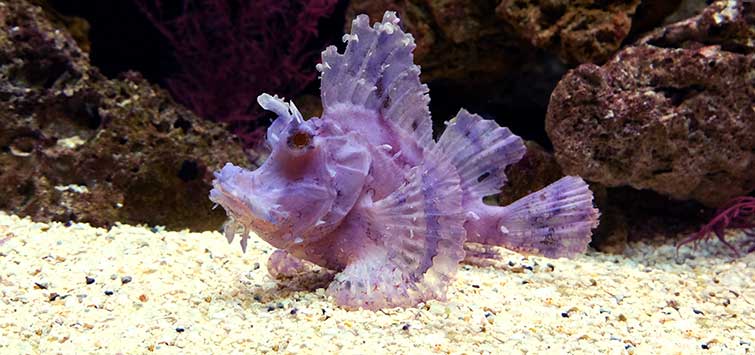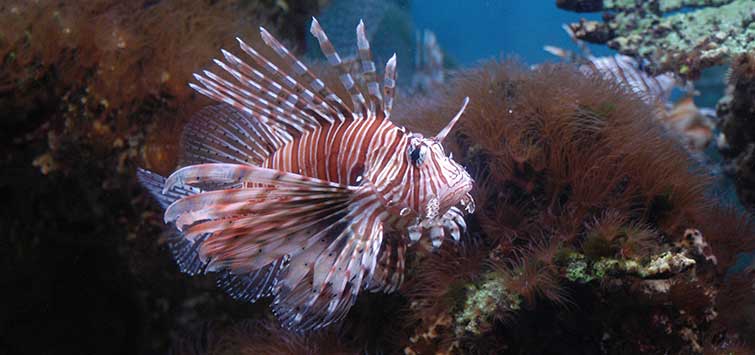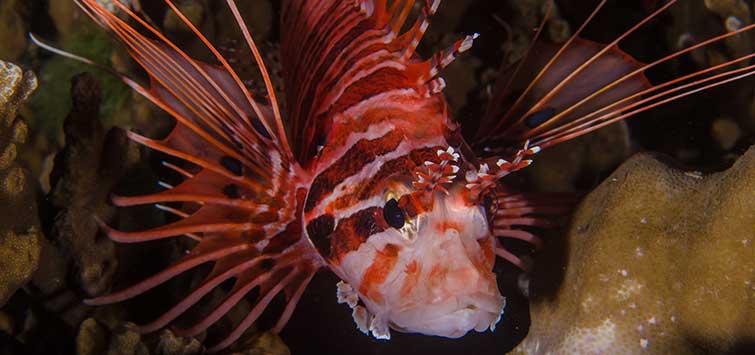Rhinopias Scorpionfish
Author: Jeremy Gosnell
Striking coloration and atypical looks make these predatory fish a Holy Grail for marine aquarists.
My Own Little World
Being a marine aquarist allows you to see and do things that very few people have. For me—someone who loves the recreational sport of scuba diving—waking up to a miniature coral reef each morning is a perfect way to expand upon my respect of the ocean.
Why Be an Aquarist?
The benefits of keeping marine aquaria are numerous, but often it is the combination of little things that adds up to a greater sense of reward than any one accomplishment could. On the one hand, many coral-reef fish come from some of the most pristine ecosystems on planet Earth. Keeping them healthy and active in an aquarium is an impressive feat, and having them spawn is nothing short of amazing.
Another benefit to keeping a marine aquarium is getting to see fish that are exotic. They come from locations that are very remote, and they are often captured for the trade by people whose lifestyle is far more traditional and simple than our own. These animals are colorful, unique, strange, and exciting.
Fun Challenges
It is for that reason that I have become an aquarist who appreciates things that are rare and challenging to keep. Over the years I have kept several not-so-common species in my aquarium, including a chevron tang, polleni grouper, Achilles tang, and a blueface angelfish. Several others have, of course, swum in the waters of my aquarium during my time as an aquarist.
One fish in particular, however, takes the cake because of its rarity in the hobby and overall uniqueness: the Rhinopias scorpionfish.
Rhinopias Basics
These animals come from several areas around the world, with some hailing from Australia while others come from Indonesia. They are tough to spot, even for a seasoned diver. Their unique camouflage blends in perfectly with the reef and the gentle swaying of the current moves them naturally with their surroundings. It’s this ability to blend in that makes them not only rare in the aquarium trade but very, very expensive when they do appear.
While these fish are expensive, they tend to be very hardy once properly acclimated and will do well in a captive environment if their special needs are met. Another argument in favor of keeping Rhinopias is the fact that they do not require as large of an aquarium to survive as you might think based on their size. Although they are far from tiny, they rarely move about the reef, so spacious accommodations are not as important as they would be for a more active, open-water-swimming species.
Rhinopias in the Aquarium Trade
Several species of Rhinopias are occasionally offered for sale, such as the weedy scorpionfish Rhinopias frondosa andEschmeyer’s scorpionfish R. eschmeyeri. The weedy scorpionfish is wide ranging, occurring in locations such as East Africa up through to Japan. Many species that are collected for our aquariums come from Sri Lanka. These fish grow to a maximum size of around 9 inches. On the reef they can be found at a depth of about 10 feet all the way down to 300 feet, enjoying rocky or rubble-based bottoms.
Eschmeyer’s scorpionfish has also been reported around Sri Lanka ranging into the Philippines, with the species being observed in Indonesia as well. They are usually a uniform purple or yellow in color. They can be found on the natural coral reef at a depth of about 10 to 130 feet and grow to about 7½ inches in the aquarium.
Interesting Behaviors
There are several characteristics these scorpionfish display that often worry many aquarists. First, they don’t swim much, if at all. They prefer to use their fins and slowly crawl along the bottom. Typically these animals find a comfortable spot on a sandy bottom in the aquarium and set up shop. They rarely move and will sway to and fro in the tank’s natural current, mimicking a strand of algae.
Rhinopias scorpionfish also often shed their cuticle (an outer layer of skin). These animals spend so much time in one place that parasites and algae can easily accumulate on their skin, so to combat this problem, the Rhinopias will shed its outer layer of cuticle. Often before shedding, the fishes’ eyes will become cloudy and aquarists may even witness a fungus-like layer of skin coming off. Don’t be alarmed! In fact, regular shedding of the cuticle is a definite sign of a healthy scorpionfish.
Feeding
Feeding is often the main challenge when keeping a scorpionfish, especially for Rhinopias. The bad news is that many specimens will never accept anything other then live fare. As you can imagine, constantly feeding any fish live foods is not only difficult but expensive. The good news is that these ambush predators do not need to eat every day. In fact, it is best to feed a Rhinopias to satiation twice per week.
Live Foods
Typically when you first get one of these fish, it will only eat live foods. I chose to feed my Rhinopias live mollies because they could be acclimated to salt water and were much cheaper then a diet of damselfish.
I always fed the mollies a garlic-infused pellet food and acclimated them to the marine environment before offering them to the Rhinopias. Eventually I switched over to offering non-living fish, and soon my fish began taking the dead mollies with as much zest as the live ones. I then transitioned the Rhinopias over to frozen silversides. One thing I did notice when making the switch over to frozen foods was that only whole frozen silversides did the trick. Anything else (such as chopped silversides or squid) did not work.
Frozen Food Approach
Sadly, I cannot guarantee that other scorpionfish are going to transition over to eating frozen foods. I found that not rushing my fish to transition and taking it slowly, one step at a time, was the best approach. Don’t get discouraged if your animal doesn’t take frozen foods the first time you offer them; it may take a while.
Tankmates
Those wishing to keep Rhinopias with tankmates should keep in mind four things. Of course these are just my recommendations, but to me it seems to make the tank environment more harmonious.
Don’t Forget About the Venom
First, like all scorpionfish, Rhinopias are venomous. Luckily they are pretty laid back (at least in my experience) about arming their venomous dorsal spines and using them. One problem is that when the scorpionfish begins to grow algae on its outer layer of skin surgeonfish tend to take an interest in the algae. This increases the risk of the surgeonfish being stung by the scorpion’s venomous spines. I keep my rhino with two surgeonfish and have never had a problem with either of them getting stung, but they have gotten pretty close to those toxic spines.
Carnivorous Scorpionfish
The second major consideration is, of course, the fact that scorpionfish eat other fish with gusto. Just because a tankmate looks too big to fit in the rhino’s mouth doesn’t mean it won’t end up on the menu. Rhinopias can open their mouths to a huge size. I have seen images from coral reefs around Raja Ampat, Indonesia showing a scorpionfish ingesting prey nearly as large as itself.
Water Changes
My third recommendation is to adhere to a strict water-change schedule. As scorpionfish are heavy feeders, waste levels in the aquarium will be high, requiring a lot of water changes. Keeping the water pristine is not only great for the scorpionfish, but also benefits any tankmates as well.
Avoiding Competition
Finally, do not keep a rhino with any other predatory fish that may compete for food. My rhino is kept with a 6-inch polleni grouper, and feeding time is pretty tricky. Both the rhino and the grouper want the food, though the grouper moves more like a torpedo and the rhino more like an elderly man. Being an ambush predator, Rhinopias prefer to sit and wait for a meal to come to them rather than chase it down like groupers do. When keeping a rhino with another predator, you essentially have to feed the faster (or possibly fatter) predator to satiation, and then focus on the Rhinopias. This of course takes much more time, and the other fish gets fed too much.
Other Concerns
In my humble opinion, the best place for a Rhinopias scorpionfish is a species-only nano environment. You read right, a nano environment. Small aquariums of 20 to 30 gallons work well for this species. While they grow moderately large, they barely move and require little space. Small nano aquariums can also really simplify feeding as well, since the animal usually won’t chase down a food item that swims or falls out of reach. Small space is also very helpful when doing water changes because you won’t need to change near the volume of water that you would in a large reef tank.
The main concern when keeping a Rhinopias are its venomous spines. I have never been stung by a Rhinopias (knock on wood), though I have talked to aquarists who have and the word “hospital” usually comes up during the conversation. Where I live in Maryland, most doctors or hospitals likely wouldn’t know what in the world you were talking about when telling them you got stung by your fish.
Gloves, tongs, portable barriers, and extreme caution are your best allies when working around or hand-feeding any scorpionfish.
Final Thoughts
Rhinopias scorpionfish are bizarre, rare, and exceptionally magnificent aquatic predators. They quickly become living conversation pieces and many non-aquarists are shocked to learn that this unique animal is actually a living fish. Even though Rhinopias have some different and unusual care requirements, once acclimated to the aquarium they are very hardy and easily kept, given the right conditions.
As reefkeeping and live-fish collection progresses, hopefully we will enjoy more rare and unique species in the aquarium and have methods to keep them healthy. Currently, you can’t get anything much more unique or rare in the aquarium hobby than one of these amazing underwater gems.
See the full article on TFH Digital http://www.tfhdigital.com/tfh/201008/#pg95

.png?h=595&iar=0&w=2781&hash=5FD5E69473BCC22199FBFA2FB71B6033)



